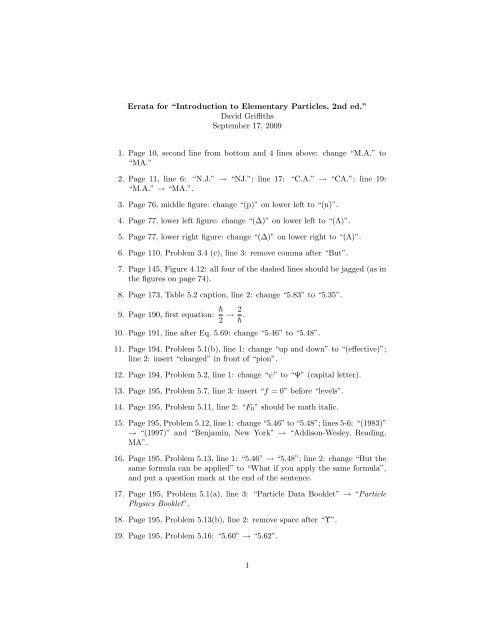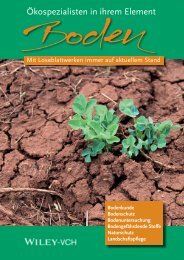Errata for “Introduction to Elementary Particles, 2nd ed.†David ...
Errata for “Introduction to Elementary Particles, 2nd ed.†David ...
Errata for “Introduction to Elementary Particles, 2nd ed.†David ...
You also want an ePaper? Increase the reach of your titles
YUMPU automatically turns print PDFs into web optimized ePapers that Google loves.
<strong>Errata</strong> <strong>for</strong> “Introduction <strong>to</strong> <strong>Elementary</strong> <strong>Particles</strong>, <strong>2nd</strong> <strong>ed</strong>.”<br />
<strong>David</strong> Griffiths<br />
September 17, 2009<br />
1. Page 10, second line from bot<strong>to</strong>m and 4 lines above: change “M.A.” <strong>to</strong><br />
“MA.”<br />
2. Page 11, line 6: “N.J.” → “NJ.”; line 17: “C.A.” → “CA.”; line 19:<br />
“M.A.” → “MA.”.<br />
3. Page 76, middle figure: change “(p)” on lower left <strong>to</strong> “(n)”.<br />
4. Page 77, lower left figure: change “(∆)” on lower left <strong>to</strong> “(Λ)”.<br />
5. Page 77, lower right figure: change “(∆)” on lower right <strong>to</strong> “(Λ)”.<br />
6. Page 110, Problem 3.4 (c), line 3: remove comma after “But”.<br />
7. Page 145, Figure 4.12: all four of the dash<strong>ed</strong> lines should be jagg<strong>ed</strong> (as in<br />
the figures on page 74).<br />
8. Page 173, Table 5.2 caption, line 2: change “5.83” <strong>to</strong> “5.35”.<br />
9. Page 190, first equation:<br />
<br />
2 → 2 .<br />
10. Page 191, line after Eq. 5.69: change “5.46” <strong>to</strong> “5.48”.<br />
11. Page 194, Problem 5.1(b), line 1: change “up and down” <strong>to</strong> “(effective)”;<br />
line 2: insert “charg<strong>ed</strong>” in front of “pion”.<br />
12. Page 194, Problem 5.2, line 1: change “ψ” <strong>to</strong> “Ψ” (capital letter).<br />
13. Page 195, Problem 5.7, line 3: insert “f = 0” be<strong>for</strong>e “levels”.<br />
14. Page 195, Problem 5.11, line 2: “F 0 ” should be math italic.<br />
15. Page 195, Problem 5.12, line 1: change “5.46” <strong>to</strong> “5.48”; lines 5-6: “(1983)”<br />
→ “(1997)” and “Benjamin, New York” → “Addison-Wesley, Reading,<br />
MA”.<br />
16. Page 195, Problem 5.13, line 1: “5.46” → “5.48”; line 2: change “But the<br />
same <strong>for</strong>mula can be appli<strong>ed</strong>” <strong>to</strong> “What if you apply the same <strong>for</strong>mula”,<br />
and put a question mark at the end of the sentence.<br />
17. Page 195, Problem 5.1(a), line 3: “Particle Data Booklet” → “Particle<br />
Physics Booklet”.<br />
18. Page 195, Problem 5.13(b), line 2: remove space after “Υ”.<br />
19. Page 195, Problem 5.16: “5.60” → “5.62”.<br />
1
20. Page 196, Problem 5.21: change “(See Halzen . . . 2.19.)” <strong>to</strong> “, assuming<br />
m u = m d .”, and put the following sentence in parentheses.<br />
21. Page 196, Problem 5.23, line 1: change “Equations 5.12, 5.13 and” <strong>to</strong><br />
“Problem 5.2 and Equation”; line 2: at the end, add “Express your answer<br />
in terms of α, m, c, and . (We will use this result in Chapter 7, when we<br />
calculate the lifetime of positronium.)”.<br />
22. Page 223, change Problem 6.14 <strong>to</strong> read:<br />
Find dσ/dΩ and σ <strong>for</strong> A + A → B + B in the lab frame<br />
(target A at rest). Assume m B = m C = 0, and the incident A<br />
is nonrelativistic. Express your answer in terms of the mass (m)<br />
and spe<strong>ed</strong> (v) of the incident particle, and keep only the lowest<br />
order (in v/c ≪ 1).<br />
23. Page 230, line after Equation 7.28: change “5.10” <strong>to</strong> “5.3”.<br />
24. Page 256, last line of first footnote: change “7.40” <strong>to</strong> “7.41”.<br />
25. Page 263, second line after Eq. 7.181: change “7.174” <strong>to</strong> “Eq. 7.178”.<br />
26. Page 267, reference 7, last line: change “pp. 216 ff” <strong>to</strong> “Section 4.7”.<br />
27. Page 270, Problem 7.22, at end: add “Assume A 0 was constant in the<br />
distant past.”.<br />
28. Page 271, Problem 7.31(a): change “in Section 7.7” <strong>to</strong> “on page 252”.<br />
29. Page 272, Problem 7.45, line 2: replace “In the experiment . . . pr<strong>ed</strong>iction.”<br />
with “What if the CM energy is 57.8 GeV? [This was the value us<strong>ed</strong> in<br />
the experiment [9], but that was <strong>for</strong> inelastic electron/positron scattering,<br />
so don’t expect <strong>to</strong> match their result (α −1 = 129).]”<br />
30. Page 273, Problem 7.49(e), last line: change mc <strong>to</strong> m e c.<br />
31. Page 273, Problem 7.51(b), line 2: change σ y <strong>to</strong> σ 2 ; also in the display<strong>ed</strong><br />
equation in part (c).<br />
32. Page 282, line be<strong>for</strong>e Eq. 8.19: remove parentheses around “8.18”.<br />
33. Page 291, line after Eq. 8.51: change “8.23” <strong>to</strong> “8.13”.<br />
34. Page 303, Problem 8.4, line 6: no line break after “8.3).”; the line break<br />
would be excellent right be<strong>for</strong>e “then”, with “and the x’s might as well”<br />
mov<strong>ed</strong> <strong>to</strong> the last line. The text on the line in between should be rais<strong>ed</strong>,<br />
so it is center<strong>ed</strong> with respect <strong>to</strong> the three matrices:<br />
then q µ L µν = 0 ⇒ L µν =<br />
(· · · 0<br />
· · · 0<br />
· · · 0<br />
0 0 0 0<br />
)<br />
. So L µν K νµ = L µν =<br />
(· · · 0<br />
· · · 0<br />
· · · 0<br />
0 0 0 0<br />
) ( · · · x<br />
)<br />
· · · x<br />
· · · x<br />
x x x x<br />
2
35. Page 303, Problem 8.11, line 5: remove open parentheses in front of “Fischbach”.<br />
36. Page 304, Problem 8.21, line 4: insert “(Section 8.5)” be<strong>for</strong>e “is gaugeinvariant”.<br />
37. Page 306, Problem 8.24(a), line 1: change “8.86” <strong>to</strong> “8.92”.<br />
38. Page 306, Problem 8.25: change “9.69” <strong>to</strong> “8.93” (twice).<br />
39. Page 306, Problem 8.26, change “9.71” <strong>to</strong>“8.95”.<br />
40. Page 331, the second diagram should be:<br />
e<br />
e<br />
n e<br />
W<br />
W<br />
n m<br />
m<br />
n m<br />
41. Page 364, Eq. 10.61: raise the prime on A ′ µ, as in Eq. 10.60.<br />
42. Page 368, Eq. 10.83: the first φ should be bold face (like the second).<br />
43. Page 369, Equation 10.89: λ should be bold face.<br />
44. Page 371, be<strong>for</strong>e and after Eq. 10.101: modify <strong>to</strong> read<br />
. . . simply rub out the field variables. (This naive rule doesn’t<br />
get all the c’s and ’s right—what we actually erase is φ/ √ c 1/3<br />
<strong>for</strong> a scalar field φ, A µ / √ √<br />
4πc 1/3 <strong>for</strong> a vec<strong>to</strong>r field A µ , and<br />
c 1/3 ψ <strong>for</strong> a spinor field ψ.) Thus<br />
√<br />
4π<br />
−i<br />
c qγµ = ig e γ µ (QED vertex fac<strong>to</strong>r) (10.101)<br />
In the case of chromodynamics (Equation 10.88) the quarkgluon<br />
coupling . . .<br />
45. Page 384, Answers <strong>to</strong> Problem 10.12(b): change “g” <strong>to</strong> “q” (twice).<br />
46. Page 384, Problem 10.14(c): change “4.20(c)” <strong>to</strong> “4.19(a)”.<br />
47. Page 387, first paragraph of Section 11.1, lines 1, 6, and 9: change<br />
“Rayleigh” <strong>to</strong> “Kelvin”.<br />
48. Page 402, last line of text: change −im f c 2 /v <strong>to</strong> −im f c 2 /v √ c.<br />
49. Page 403, first line: change 2iM 2 mc 2 g µν /( 2 v) <strong>to</strong> 2iM 2 mc 3 g µν /v √ c.<br />
3
50. Page 403, line after first figure: change −3im 2 h c2 /( 2 v) <strong>to</strong> −3im 2 h c3 /v.<br />
51. Page 407, penultimate footnote, line 2: change “has n” <strong>to</strong> “has n 2 ”.<br />
52. Page 419, Problem 12.1(a), second line: change g w <strong>to</strong> (g w /2).<br />
53. Page 419, Problem 12.3(b), bot<strong>to</strong>m line: change “120” <strong>to</strong> “200”.<br />
4






